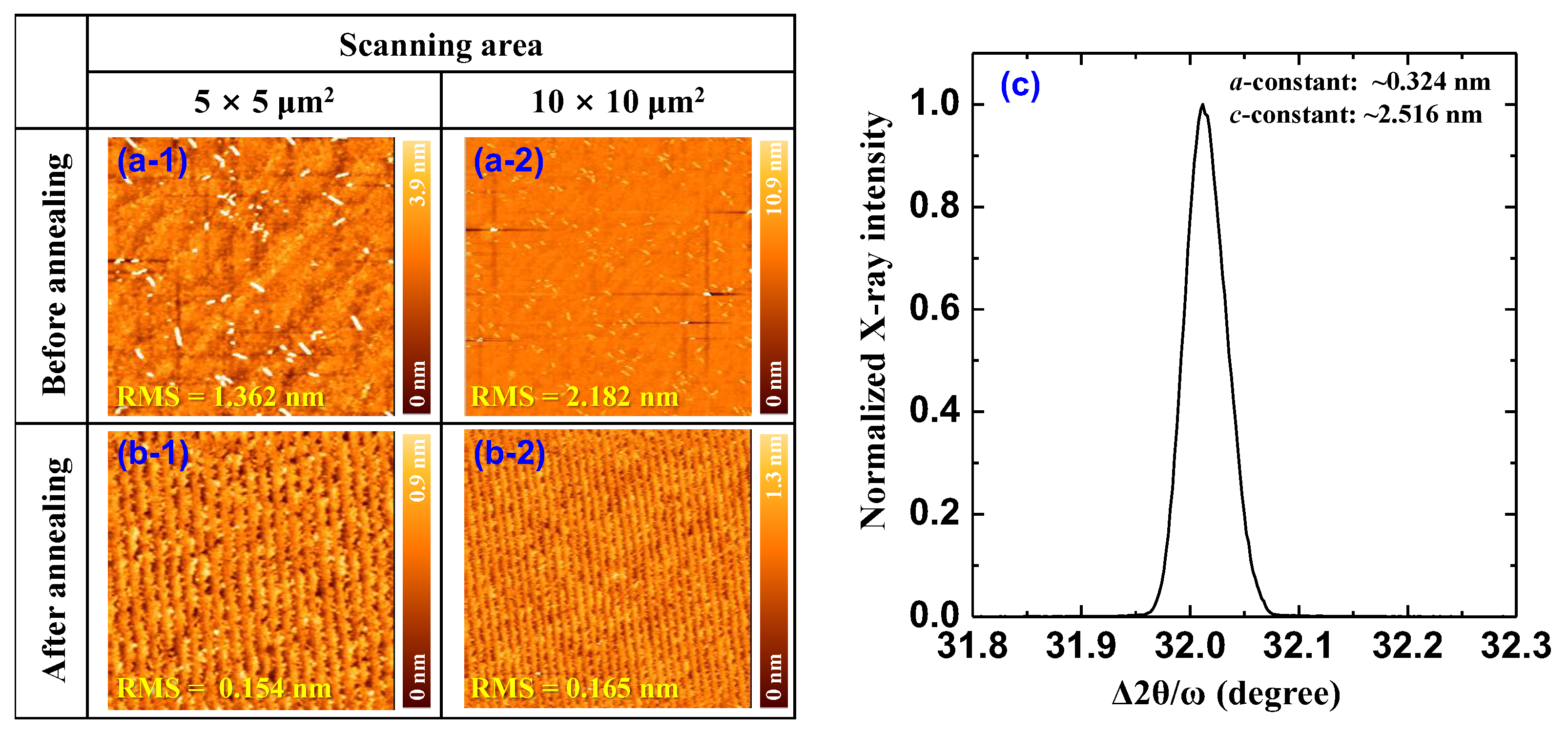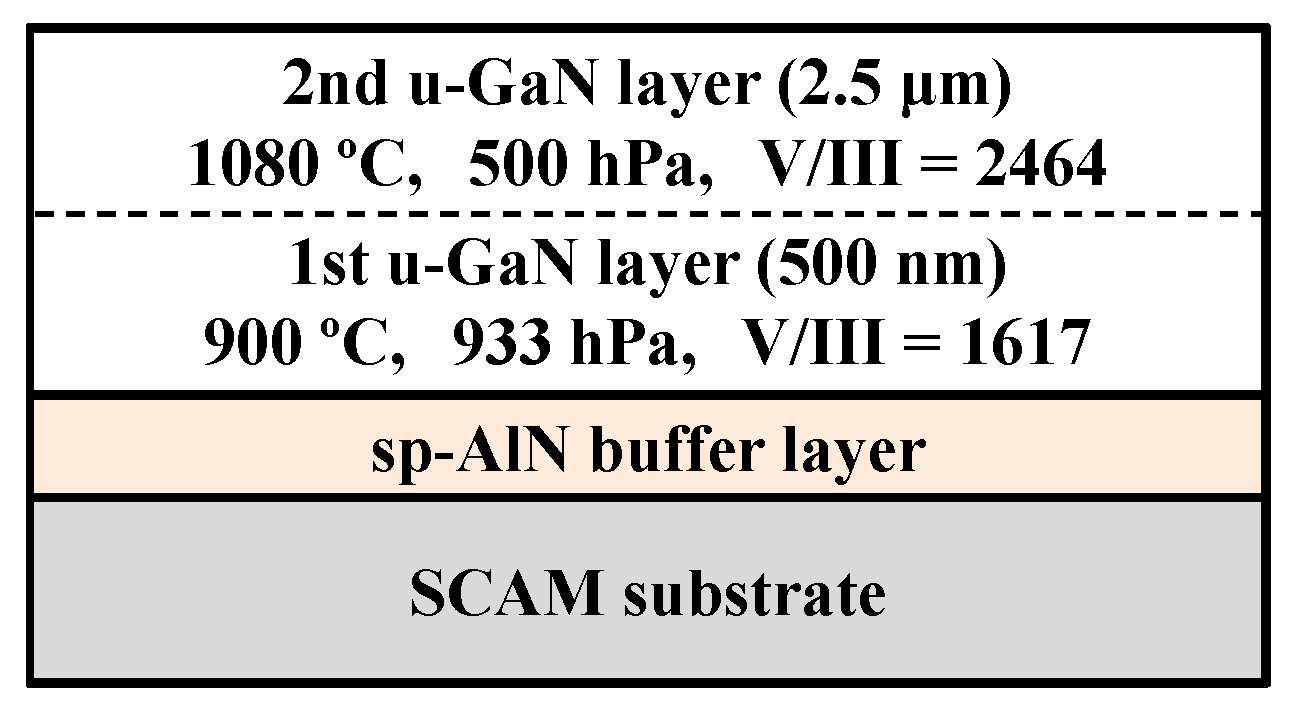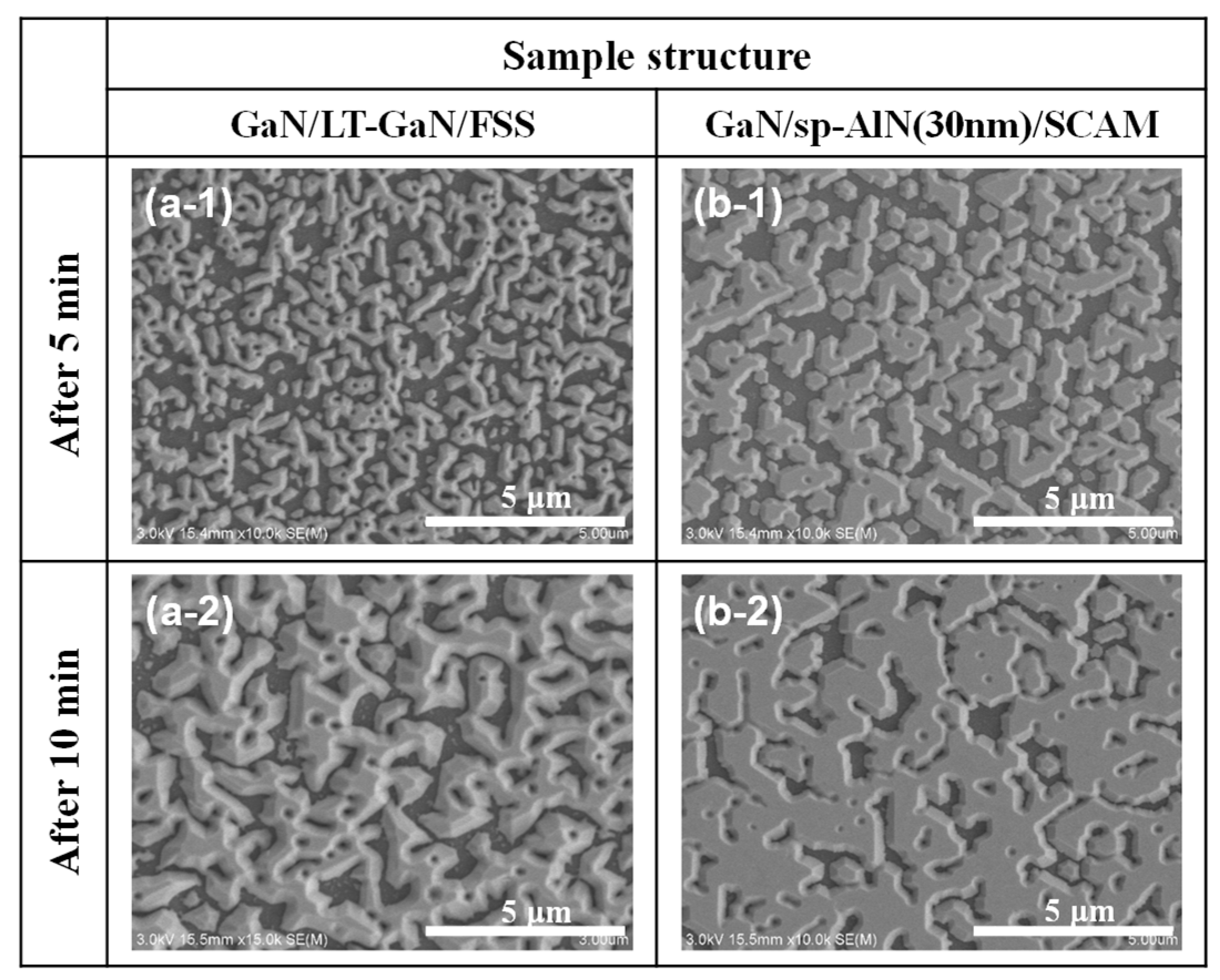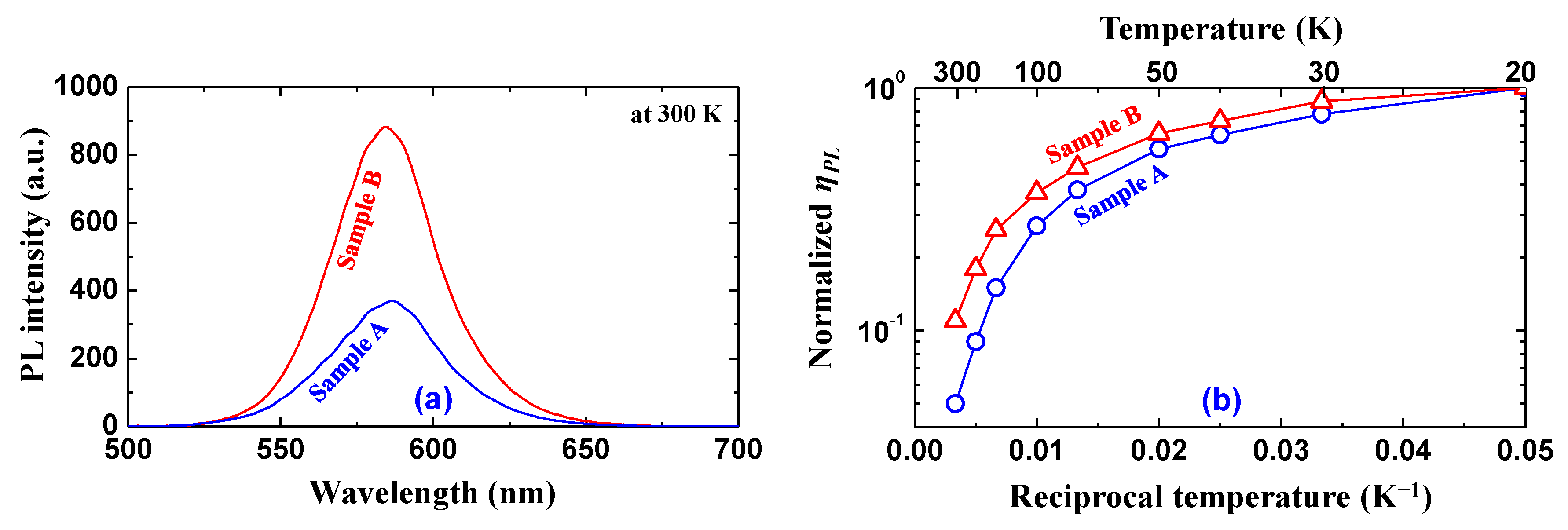Growth of Ga0.70In0.30N/GaN Quantum-Wells on a ScAlMgO4 (0001) Substrate with an Ex-Situ Sputtered-AlN Buffer Layer
Abstract
:1. Introduction
2. Preparation of the SCAM Substrate
3. Optimization of the Ex-Situ sp-AlN Buffer Layer Thickness and Characterization of the GaN/sp-AlN/SCAM
4. Growth and Evaluation of Ga0.70In0.30N/GaN QWs on SCAM Substrate with a 30 nm Thick Ex-Situ sp-AlN Buffer Layer
5. Summary
Author Contributions
Funding
Institutional Review Board Statement
Informed Consent Statement
Data Availability Statement
Acknowledgments
Conflicts of Interest
References
- Amano, H.; Akasaki, I.; Hiramatsu, K.; Koide, N.; Sawaki, N. Effects of the buffer layer in metalorganic vapour phase epitaxy of GaN on sapphire substrate. Thin Solid Film. 1995, 163, 415–420. [Google Scholar] [CrossRef]
- Amano, H.; Iwaya, M.; Kashima, T.; Katsuragawa, M.; Akasaki, I.; Han, J.; Hearne, S.; Floro, J.A.; Chason, E.; Figiel, J. Stress and Defect Control in GaN Using Low Temperature Interlayers. Jpn. J. Appl. Phys. 1998, 37, L1540–L1542. [Google Scholar] [CrossRef]
- Akasaki, I. Key inventions in the history of nitride-based blue LED and LD. J. Cryst. Growth 2007, 300, 2–10. [Google Scholar] [CrossRef]
- Akasaki, I. Nobel Lecture: Fascinating journeys into blue light. Rev. Mod. Phys. 2015, 87, 1119–1131. [Google Scholar] [CrossRef]
- Amano, H. Nobel Lecture: Growth of GaN on sapphire via low-temperature deposited buffer layer and realization of p-type GaN by Mg doping followed by low-energy electron beam irradiation. Rev. Mod. Phys. 2015, 87, 1133–1138. [Google Scholar] [CrossRef]
- Nakamura, S. Nobel Lecture: Background story of the invention of efficient blue InGaN light emitting diodes. Rev. Mod. Phys. 2015, 87, 1139–1151. [Google Scholar] [CrossRef]
- Han, D.-P.; Shin, D.-S.; Shim, J.-I.; Kamiyama, S.; Takeuchi, T.; Iwaya, M.; Akasaki, I. Modified Shockley Equation for GaInN-Based Light-Emitting Diodes: Origin of the Power-Efficiency Degradation under High Current Injection. IEEE J. Quantum Electron. 2019, 55, 3200311. [Google Scholar] [CrossRef]
- Parbrook, P.J.; Corbett, B.; Han, J.; Seong, T.-Y.; Amano, H. Micro-Light Emitting Diode: From Chips to Applications. Laser Photonics Rev. 2021, 15, 2000133. [Google Scholar] [CrossRef]
- Han, D.-P.; Lee, G.W. Comparative study of III-phosphide- and III-nitride-based light-emitting diodes: Understanding the factors limiting efficiency. Semicond. Sci. Technol. 2021, 36, 115004. [Google Scholar] [CrossRef]
- Iwaya, M.; Takeuchi, T.; Yamaguchi, S.; Wetzel, C.; Amano, H.; Akasaki, I. Reduction of Etch Pit Density in Organometallic Vapor Phase Epitaxy-Grown GaN on Sapphire by Insertion of a Low-Temperature-Deposited Buffer Layer between High-Temperature-Grown GaN. Jpn. J. Appl. Phys. 1998, 37, L316–L318. [Google Scholar] [CrossRef]
- Iida, D.; Zhuang, Z.; Kirilenko, P.; Velazquez-Rizo, M.; Najmi, M.A.; Ohkawa, K. 633-nm InGaN-based red LEDs grown on thick underlying GaN layers with reduced in-plane residual stress. Appl. Phys. Lett. 2020, 116, 162101. [Google Scholar] [CrossRef]
- Benzarti, Z.; Sekrafi, T.; Bougrioua, Z.; Khalfallah, A.; El Jani, B. Effect of SiN Treatment on Optical Properties of InxGa1−xN/GaN MQW Blue LEDs. J. Electron. Mater. 2017, 46, 4312–4320. [Google Scholar] [CrossRef]
- Watanabe, A.; Takeuchi, T.; Hirosawa, K.; Amano, H.; Hiramatsu, K.; Akasaki, I. The growth of single crystalline GaN on a Si substrate using AlN as an intermediate layer. J. Cryst. Growth 1993, 128, 391–396. [Google Scholar] [CrossRef]
- Kukushkin, S.A.; Osipov, A.V.; Bessolov, V.N.; Medvedev, B.K.; Nevolin, V.K.; Tcarik, K.A. Substrates for epitaxy of gallium nitride: New materials and techniques. Res. Adv. Mater. Sci. 2008, 17, 1–32. [Google Scholar]
- Kobayashi, A.; Kawaguchi, Y.; Ohta, J.; Fujioka, H.; Fujiwara, K.; Ishii, A. Polarity control of GaN grown on ZnO () surfaces. Appl. Phys. Lett. 2006, 88, 181907. [Google Scholar] [CrossRef]
- Senda, R.; Miura, A.; Hayakawa, T.; Kawashima, T.; Iida, D.; Nagai, T.; Iwaya, M.; Kamiyama, S.; Amano, H.; Akasaki, I. Realization of High-Crystalline-Quality Thick m-Plane GaInN Film on 6H-SiC Substrate by Epitaxial Lateral Overgrowth. Jpn. J. Appl. Phys. 2007, 46, L948–L950. [Google Scholar] [CrossRef]
- Liu, L.; Edgar, J.H. Substrates for gallium nitride epitaxy. Mater. Sci. Eng. R Rep. 2002, 37, 61–127. [Google Scholar] [CrossRef]
- Floriduz, A.; Matioli, E. GaN growth on ScAlMgO4 substrates via thermally-dewetted thin Al films. Jpn. J. Appl. Phys. 2022, 61, 118003. [Google Scholar] [CrossRef]
- Velazquez-Rizo, M.; Najmi, M.A.; Iida, D.; Kirilenko, P.; Ohkawa, K. Microstructural analysis of N-polar InGaN directly grown on a ScAlMgO4 (0001) substrate. Appl. Phys. Express 2022, 15, 065501. [Google Scholar] [CrossRef]
- Ozaki, T.; Takagi, Y.; Nishinaka, J.; Funato, M.; Kawakami, Y. Metalorganic vapor phase epitaxy of GaN and lattice-matched InGaN on ScAlMgO4 (0001) substrates. Appl. Phys. Express 2014, 7, 091001. [Google Scholar] [CrossRef]
- Fukui, T.; Sakaguchi, T.; Matsuda, Y.; Matsukura, M.; Kojima, K.; Funato, M.; Kawakami, Y. Metalorganic vapor phase epitaxy of GaN on 2 inch ScAlMgO4 (0001) substrates. Jpn. J. Appl. Phys. 2022, 61, 090904. [Google Scholar] [CrossRef]
- Ozaki, T.; Funato, M.; Kawakami, Y. InGaN-based visible light-emitting diodes on ScAlMgO4 (0001) substrates. Appl. Phys. Express 2015, 8, 062101. [Google Scholar] [CrossRef]
- Takahashi, R.; Fujiki, R.; Hozo, K.; Hiramatsu, R.; Matsukura, M.; Kojima, T.; Han, D.-P.; Iwaya, M.; Takeuchi, T.; Kamiyama, S. Improvement of 650-nm red-emitting GaIn0.17N/GaIn0.38N multiple quantum wells on ScAlMgO4 (0001) substrate by suppressing impurity diffusion/penetration. Appl. Phys. Lett. 2022, 120, 142102. [Google Scholar] [CrossRef]
- Ozaki, T.; Funato, M.; Kawakami, Y. Red-emitting InxGa1−xN/InyGa1−yN quantum wells grown on lattice-matched InyGa1−yN/ScAlMgO4 (0001) templates. Appl. Phys. Express 2019, 12, 011007. [Google Scholar] [CrossRef]
- Jinno, D.; Otsuki, S.; Sugimori, S.; Daicho, H.; Iwaya, M.; Takeuchi, T.; Kamiyama, S.; Akasaki, I. Characterization and optimization of sputtered AlN buffer layer on r-plane sapphire substrate to improve the crystalline quality of nonpolar a-plane GaN. J. Cryst. Growth 2017, 480, 90–95. [Google Scholar] [CrossRef]
- Hu, H.; Zhou, S.; Wan, H.; Liu, X.; Li, N.; Xu, H. Effect of strain relaxation on performance of InGaN/GaN green LEDs grown on 4-inch sapphire substrate with sputtered AlN nucleation layer. Sci. Rep. 2019, 9, 3447. [Google Scholar] [CrossRef]
- Oh, J.-T.; Moon, Y.-T.; Kang, D.-S.; Park, C.-K.; Han, J.-W.; Jung, M.-H.; Sung, Y.-J.; Jeong, H.-H.; Song, J.-O.; Seong, T.-Y. High efficiency ultraviolet GaN-based vertical light emitting diodes on 6-inch sapphire substrate using ex-situ sputtered AlN nucleation layer. Opt. Express 2018, 26, 5111–5117. [Google Scholar] [CrossRef]
- Strite, S.; Morkoç, H. GaN, AlN, and InN: A review. J. Vac. Sci. Technol. B 1992, 10, 1237–1266. [Google Scholar] [CrossRef]
- Yamaguchi, T.; Sasaki, T.; Fujikawa, S.; Takahasi, M.; Araki, T.; Onuma, T.; Honda, T.; Nanishi, Y. In Situ Synchrotron X-ray Diffraction Reciprocal Space Mapping Measurements in the RF-MBE Growth of GaInN on GaN and InN. Crystal 2019, 9, 631. [Google Scholar] [CrossRef]
- Yen, C.-H.; Lai, W.-C.; Yang, Y.-Y.; Wang, C.-K.; Ko, T.-K.; Hon, S.-J.; Chang, S.-J. GaN-Based Light-Emitting Diode with Sputtered AlN Nucleation Layer. IEEE Photon. Technol. Lett. 2012, 24, 294–296. [Google Scholar] [CrossRef]
- Han, D.-P.; Ishimoto, S.; Mano, R.; Lu, W.; Iwaya, M.; Takeuchi, T.; Kamiyama, S.; Akasaki, I. Improved Reverse Leakage Current in GaInN-Based LEDs with a Sputtered AlN Buffer Layer. IEEE Photon. Technol. Lett. 2019, 31, 1971–1974. [Google Scholar] [CrossRef]
- Michałowski, P.P.; Złotnik, S.; Sitek, J.; Rosiński, K.; Rudziński, M. Oxygen-induced High Diffusion Rate of Magnesium Dopants in GaN/AlGaN Based UV LED Heterostructures. Phys. Chem. Chem. Phys. 2018, 20, 13890–13895. [Google Scholar] [CrossRef] [PubMed]
- Chowdhury, S.; Swenson, B.L.; Lu, J.; Mishra, U.K. Use of sub-nanometer thick AlN to arrest diffusion of ion-implanted Mg into regrown AlGaN/GaN layers. Jpn. J. Appl. Phys. 2011, 50, 101002. [Google Scholar] [CrossRef]
- Kobayashi, K.; Yamaguchi, A.; Kimura, S.; Sunakawa, H.; Kimura, A.; Usui, A. X-Ray Rocking Curve Determination of Twist and Tilt Angles in GaN Films Grown by an Epitaxial-Lateral-Overgrowth Technique. Jpn. J. Appl. Phys. 1999, 38, L611–L613. [Google Scholar] [CrossRef]
- Miyake, H.; Lin, C.-H.; Tokoro, K.; Hiramatsu, K. Preparation of high-quality AlN on sapphire by high-temperature face-to-face annealing. J. Cryst. Growth 2016, 456, 155–159. [Google Scholar] [CrossRef]
- Iwabuchi, T.; Kuboya, S.; Hagiwara, C.; Tanikawa, T.; Hanada, T.; Fukuda, T.; Matsuoka, T. Reduction of Impurity Incorporation into MOVPE-grown GaN films on ScAlMgO4 Substrate. In Proceedings of the 2017 International Conference on Solid State Devices and Materials, Sendai, Japan, 19–22 September 2017; pp. 311–312. [Google Scholar]
- Fini, P.; Wu, X.; Tarsa, E.J.; Golan, Y.; Srikant, V.; Keller, S.; Denbaars, S.P.; Speck, J.S. The effect of growth environment on the morphological and extended defect evolution in GaN grown by metalorganic chemical vapor deposition. Jpn. J. Appl. Phys. 1998, 37, 4460–4466. [Google Scholar] [CrossRef]
- Böttcher, T.; Einfeldt, S.; Figge, S.; Chierchia, R.; Heinke, H.; Hommel, D.; Speck, J.S. The role of high-temperature island coalescence in the development of stresses in GaN films. Appl. Phys. Lett. 2001, 78, 1976. [Google Scholar] [CrossRef]
- Haller, C.; Carlin, J.-F.; Jacopin, G.; Liu, W.; Martin, D.; Butté, R.; Grandjean, N. GaN surface as the source of non-radiative defects in InGaN/GaN quantum wells. Appl. Phys. Lett. 2018, 113, 111106. [Google Scholar] [CrossRef]
- Piva, F.; Santi, C.D.; Caria, A.; Haller, C.; Carlin, J.F.; Mosca, M.; Meneghesso, G.; Zanoni, E.; Grandjean, N. Defect incorporation in In-containing layers and quantum wells: Experimental analysis via deep level profiling and optical spectroscopy. J. Phys. D Appl. Phys. 2021, 54, 025108. [Google Scholar] [CrossRef]
- Han, D.-P.; Oh, C.-H.; Shin, D.-S.; Shim, J.-I.; Iwaya, M.; Takeuchi, T.; Kamiyama, S.; Akasaki, I. Thermodynamic analysis of GaInN-based light-emitting diodes operated by quasi-resonant optical excitations. J. Appl. Phys. 2020, 128, 123103. [Google Scholar] [CrossRef]
- Fujiki, R.; Takahashi, R.; Hiramatsu, R.; Hozo, K.; Han, D.-P.; Iwaya, M.; Takeuchi, T.; Kamiyama, S. Hydrogen in-situ etching of GaN surface to reduce non-radiative recombination centers in 510-nm GaInN/GaN quantum-wells. J. Cryst. Growth 2022, 593, 126751. [Google Scholar] [CrossRef]
- Henning, P.; Sidikejiang, S.; Horenburg, P.; Bremers, H.; Rossow, U.; Hangleiter, A. Unity quantum efficiency in III-nitride quantum wells at low temperature: Experimental verification by time-resolved photoluminescence. Appl. Phys. Lett. 2021, 119, 011106. [Google Scholar] [CrossRef]
- Bell, A.; Christen, J.; Bertram, F.; Ponce, F.A. Localization versus field effects in single InGaN quantum wells. Appl. Phys. Lett. 2004, 84, 58–60. [Google Scholar] [CrossRef]
- Shen, Y.C.; Mueller, G.O.; Watanabe, S.; Gardner, N.F.; Munkholm, A.; Krames, M.R. Auger recombination in InGaN measured by photoluminescence. Appl. Phys. Lett. 2007, 91, 141101. [Google Scholar] [CrossRef]
- Schubert, M.F.; Xu, J.; Dai, Q.; Mont, F.W.; Kim, J.K.; Schubert, E.F. On resonant optical excitation and carrier escape in GaInN/GaN quantum wells. Appl. Phys. Lett. 2009, 94, 081114. [Google Scholar] [CrossRef]
- David, A.; Young, N.G.; Lund, C.; Craven, M.D. Review—The Physics of Recombinations in III-Nitride Emitters. ECS J. Solid State Sci. Technol. 2020, 9, 016021. [Google Scholar] [CrossRef]








Disclaimer/Publisher’s Note: The statements, opinions and data contained in all publications are solely those of the individual author(s) and contributor(s) and not of MDPI and/or the editor(s). MDPI and/or the editor(s) disclaim responsibility for any injury to people or property resulting from any ideas, methods, instructions or products referred to in the content. |
© 2023 by the authors. Licensee MDPI, Basel, Switzerland. This article is an open access article distributed under the terms and conditions of the Creative Commons Attribution (CC BY) license (https://creativecommons.org/licenses/by/4.0/).
Share and Cite
Zheng, D.-G.; Min, S.; Kim, J.; Han, D.-P. Growth of Ga0.70In0.30N/GaN Quantum-Wells on a ScAlMgO4 (0001) Substrate with an Ex-Situ Sputtered-AlN Buffer Layer. Materials 2024, 17, 167. https://doi.org/10.3390/ma17010167
Zheng D-G, Min S, Kim J, Han D-P. Growth of Ga0.70In0.30N/GaN Quantum-Wells on a ScAlMgO4 (0001) Substrate with an Ex-Situ Sputtered-AlN Buffer Layer. Materials. 2024; 17(1):167. https://doi.org/10.3390/ma17010167
Chicago/Turabian StyleZheng, Dong-Guang, Sangjin Min, Jiwon Kim, and Dong-Pyo Han. 2024. "Growth of Ga0.70In0.30N/GaN Quantum-Wells on a ScAlMgO4 (0001) Substrate with an Ex-Situ Sputtered-AlN Buffer Layer" Materials 17, no. 1: 167. https://doi.org/10.3390/ma17010167
APA StyleZheng, D.-G., Min, S., Kim, J., & Han, D.-P. (2024). Growth of Ga0.70In0.30N/GaN Quantum-Wells on a ScAlMgO4 (0001) Substrate with an Ex-Situ Sputtered-AlN Buffer Layer. Materials, 17(1), 167. https://doi.org/10.3390/ma17010167





